Table of Contents
Water
- Water is the most important substance for every single living being.
- Water is essential for life to exist on the earth.
- It is also habitat for aquatic life.
- It is made out of three atoms, two hydrogen and one oxygen.
- About 70% of the earth’s surface is covered with water.
- You will be surprised to know that only 2.6% of the total water resources of the world consist of fresh water.
- It is essential for our various life processes like digestion and transportation of materials in body.

Image:- Water
- Water is also keep our body cool.
- It is available everywhere on the earth.
- There are vast oceans, seas, rivers, lakes and streams scattered all over the earth’s surface which is one of the sources of water.
- Water is also used for various other purposes such as drinking, washing, cooking, irrigation, hydroelectricity generation, etc.
- It cools the atmosphere in the form of rain.
- Oceans are the main source of water vapour in the atmosphere.
- We can’t imagine life on the earth without water.
Definition of Water
- Water is a substance which is made of tiny molecules of hydrogen and oxygen.
- They don’t have any shape or colour when it is pure.
Sources of Water
- The following are the different sources of water on the earth:-
1. Rain water
2. Surface water
3. Ground water
1. Rain water
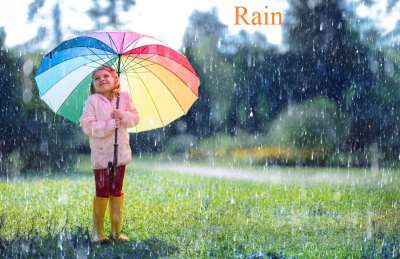
Image:- Rainwater
- Water that is condensed from water vapour in the atmosphere and falls as drops on earth is called rain water or rainfall.
- Rain is the main source of natural water on the earth.
- It is the purest form of water but has dust and dissolved gases in it.
- Some of the water that falls during rainfall is lost as run off.
- This water enters the rivers and oceans.
- The remaining water seeps into the ground through the soil and arrives at the hard rock gathering there as ground water.
- The ground water is used by plants for their growth, and is often used by humans for meeting their daily needs.
2. Surface water
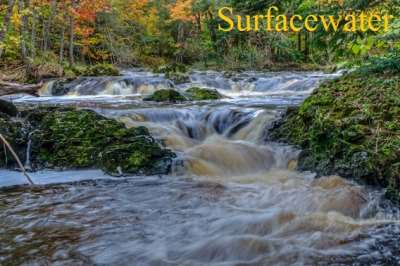
Image:- Surface water
- The water that is present on the surface of the earth is called surface water.
- It includes lakes, ponds, oceans, rivers, etc.
- It comes in these water bodies after flowing through mountains and plains.
- So, it gets mixed with dust, small stones, salts, dirt and minerals, i.e. it is unfit for direct consumption.
- Besides this, garbage, excreta of human beings and animals, organic matter, fertilisers, pesticides, etc. also get mixed with this water.
- So, this water becomes unfit even for washing and cleaning.
- Ocean and sea water contain a large quantity of salt in it.
- This condition is called salinity.
3. Ground water

Image:- Groundwater
- Water that seeps through the soil, sand and rocks gets collected underground to form a reservoir of water is called groundwater.
- It is usually pure as it passes through the soil which acts as a natural filter.
- It is used both for drinking and irrigation purposes.
- Drinking water is mainly obtained in India from wells and springs.
- In case of wells, it is important that the water for drinking purposes is obtained from deeper layers.
- The flow of water in the form of natural fountains from the earth’s surface is called a spring.
- Mineral water is often spring water as it contains dissolved minerals from the surrounding rocks.
Forms of Water
- There are three forms of water which are as follows:-
1. Solid Form
2. Liquid Form
3. Gaseous Form
1. Solid Form
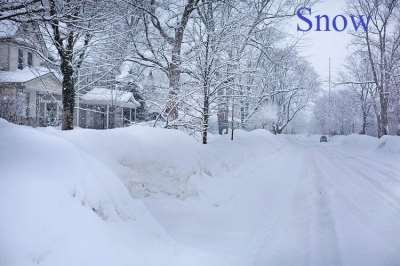
Image:- Snow ( Solid )
- Water that is present in the form of snow and ice caps is known as solid form of water.
- It mostly presents at the poles of earth, mountains and glaciers.
2. Liquid Form
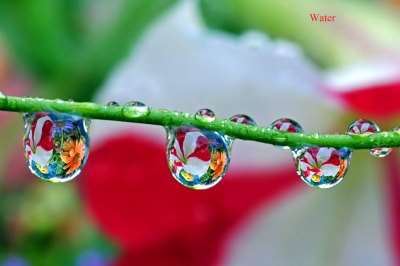
Image:- Water ( Liquid )
- Water that is present in the oceans, lakes, rivers, ponds, well, etc. is known as liquid form of water.
- Mostly is fresh water but ocean water is saline.
3. Gaseous Form
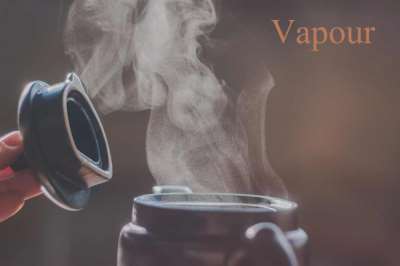
Image:- Vapour ( Gas )
- Water that is present in the form of vapour in the air is known as gaseous form of water.
Notes:
- All these various forms of water in nature are happens due to the temperature of a place.
Water Cycle
- The cyclic pattern in which water keeps moving from oceans and seas to the sky as water vapour, from the sky to the land as rain or snow, and from land to the oceans and seas as surface water is known as the water cycle.
- It is a continuous process that occurs in nature.
- It has no beginning or end.
- It starts from the evaporation of water from water bodies by the heat of the sun to vapour.
- This vapour is lighter than air and rises up in the atmosphere.

Image:- Water Cycle
- The temperature of the upper atmosphere becomes so low that the vapour condenses to form water droplets.
- These water droplets collect together to form bigger drops.
- When these drops become too heavy to float in air, they start falling down on the earth.
- This process is known as precipitation.
- Some of the rainwater seeps through soil to recharge groundwater.
- Rest of it goes to water bodies from where it enters the cycle of evaporation and condensation again.
- The water cycle ensures the availability of water to all living organisms.
Conclusion
- It driven by two forces:-
1. Heat from the sun which causes evaporate.
2. The gravitational pull of the earth which brings the water vapour back to the earth as precipitation and moves it in the streams and underground flow.
Type of Water
- There are two types of water which are as follows:-
1. Hard water
2. Soft water
1. Hard water
- The water that is unfit for drinking is known as hard water.
- They don’t form lather with soap easily.
- Hardness is the soap consuming capacity of water.
- The hardness of water because of the presence of Ca and Mg salt in it.
- And other ions are also responsible for harness are Al3+ , Fe3+ and Mn2+ .
- If Ca and Mg salts are present in water then it react with the soluble sodium soap to form insoluble salts calcium and magnesium.
- There are two types of hardness which are as follows:-
i. Temporary hardness
ii. Permanent hardness
i. Temporary hardness
- Temporary hardness is caused by due to the presence of dissolved bicarbonates of Ca, and Mg.
- It is also known as alkaline hardness.
- This hardness is easily removed by heating.
- Hardness is expressed in the terms of CaCO3 equivalents.
- The mostly insoluble salt and can be easily precipitated in water treatment process.
Chemical formula of Temporary hardness
Heat
Ca ( HCO3)2 → CaCO3 ↓ + H2O + CO2 ↑
or
Heat
Mg ( HCO3)2 → Mg ( OH )2↓ + CO2 ↑
ii. Permanent hardness
- Permanent hardness is caused due to the presence of sulphates and chlorides of Ca and Mg.
- They can’t be removed simply by boiling.
- The special methods are used for the removal of permanent hardness are lime soda process, zeolite process and ion – exchange method etc.
Difference Between Hard Water & Soft Water
| S.NO. | Hard Water | Soft Water |
| 1. | It doesn’t form lather with soap easily. | It forms lather with soap easily. |
| 2. | It contains dissolved salt of Ca & Mg. | It doesn’t contain dissolved salt of Ca & Mg. |
| 3. | More wastage of time and fuel as boiling temp. of water gets increased due to impurities. | Less wastage of time and fuel. |
| 4. | More consumption of soap by hard water. | Less consumption of soap by soft water. |
Water Conservation
- Water conservation may be defined as better utilisation of the natural sources of water and to make economic use of available water.
- There are several ways in which water can be conserved in our homes, industry and in agriculture.
- Some of the important steps are as follows:-
- We should always take care to close taps immediately after use.
- We should not waste water in our everyday life.
- Use more scientific methods which can help in better utilisation of water for irrigation.
- The most important way to conserve water is by planting more and more trees.
- Rain water can be collected in small earthen dams.
- Waste water from industry should be treated and reused as far as possible.
Methods of Water conservation
- There are five important methods for water conservation are as follows:-
1. Rain water harvesting methods
2. Terrace farming methods
3. New irrigation methods
4. Step wells methods
5. Recycling methods
1. Rain water harvesting methods

Image:- Rooftop Rainwater Harvesting
- In this methods, the rainwater running off the rooftops of houses through pipes into storage tanks.
- The storage tanks are deep pits dug into the ground to collect rainwater for recharging groundwater.
- Thus, rainwater, instead of flowing into drains, serves to recharge the groundwater level.
2. Terrace farming methods

Image:- Terrace Farming
- In this method to make crop fields on the slope of hills or mountains in the shape of stairs so that the water running down the slopes does not waste and is used to irrigate the fields collected on the lower level of the slope.
3. New irrigation methods
- In this methods, farmers should adopt better methods of irrigation so that they consume less water and make effective use of it.
- For examples drip irrigation and water sprinklers methods.
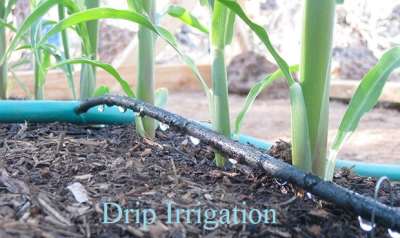
Image:- Drip Irrigation
- Drip irrigation is a method to water directly the roots of plants.
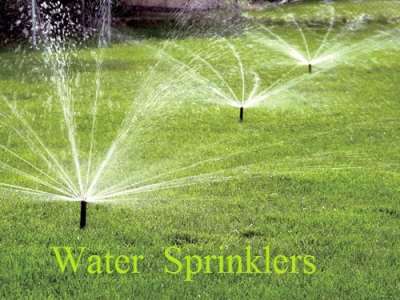
Image:- Water Sprinklers
- Water sprinklers are also effective to use less water for more areas.
4. Step wells methods

Image:- A Bawri
- It is the tradition way of collecting water through step wells ( bawris ).
- They are used in some places.
5. Recycling methods
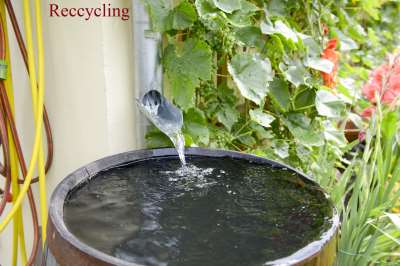
Image:- Recycling
- Recycling means the use of the same water for various purpose like water used to wash fruit and vegetables can be used to water the plants.
- It should be promoted.
Scarcity of Water
- Scarcity of water is a situation when there is an imbalance between the availability and the demand for water.
- It is a major global challenge for human beings in today’s modernised world.
- This actually involves water stress, water shortage and water crisis.
- The water crisis is a situation when available potable water within a region is less than the region’s demand.
- The natural reason behind this problem is uneven distribution of fresh water on the earth.
Causes of Water Scarcity
- There are many causes which are responsible for the scarcity of water:-
1. Increasing population
2. Global warming
3. Water pollution
4. Urbanisation
1. Increasing population
- Increasing population has increased consumption of water.
- People need more water to drink, to clean, to cook and to wash.
- People are growing more crops to meet the food demands of increasing population i.e. the demand of water in agriculture is also increasing.
- As the population is increasing, so a large number of houses are constructed.
- This will require plenty of water in construction.
2. Global warming
- Global warming, created due to environmental pollution, leads to increase in temperature day by day.
- So, water bodies are getting dried.
3. Water pollution
- Water pollution is contributing a lot towards shortage of usable water.
- Human activities are continuously making fresh water polluted, rendering unfit for human use.
4. Urbanisation
- Urbanisation and industrialisation are one of the consequences of deforestation.
- Increasing urbanisation has led to decrease in the area under forests and increase in construction areas.
- Soil allows the rainwater to seep inside the ground to recharge groundwater, where as the construction areas don’t allow water to seep in the ground.
- This leads to depletion of water table.
Effects of the Scarcity of Water
- There are many ways that the scarcity of water affects us:-
1. Power generation is mostly dependent on water. So, its scarcity leads to deficiency of electricity.
2. People who get less drinking water have face many health problems related to digestion and excretion.
3. Deficiency of water has a great impact on our hygiene system as cleaning and washing processes need a large amount of water.
4. People who face scarcity of water are not able to maintain proper cleanliness. Ultimately, they suffer from various diseases.
5. Agriculture sector faces the worst effect of water scarcity. It leads to droughts.
6. Crops dry up due to lack of water and food is not available.
7. This is not only affects farmers financially, but also limits the availability of food for living beings.
Drinking Water
- The water which is fit for drinking and cooking as well as free from bacteria or impurities are called drinking water.
- It is also known as potable water.
- It is fit for consumption by humans and other animals.
- This might be naturally potable, as is the case with pristine springs.
- Mostly groundwater has natural filtration, may need disinfection.
Specification for Drinking Water
- It should free from bacteria.
- It should be cool and clean.
- They are better in taste.
- It should be slightly alkaline.
- It should be reasonably soft and produce foam.
- There pH value should be in the range of 7 to 8.5.
- They should be free from dissolved gases like H2S, CO3 etc.
- Its turbidity should be less than 10 ppm.
- They are not contain any suspended impurities.
- It should not contain harmful materials such as lead, arsenic, chromium and copper.